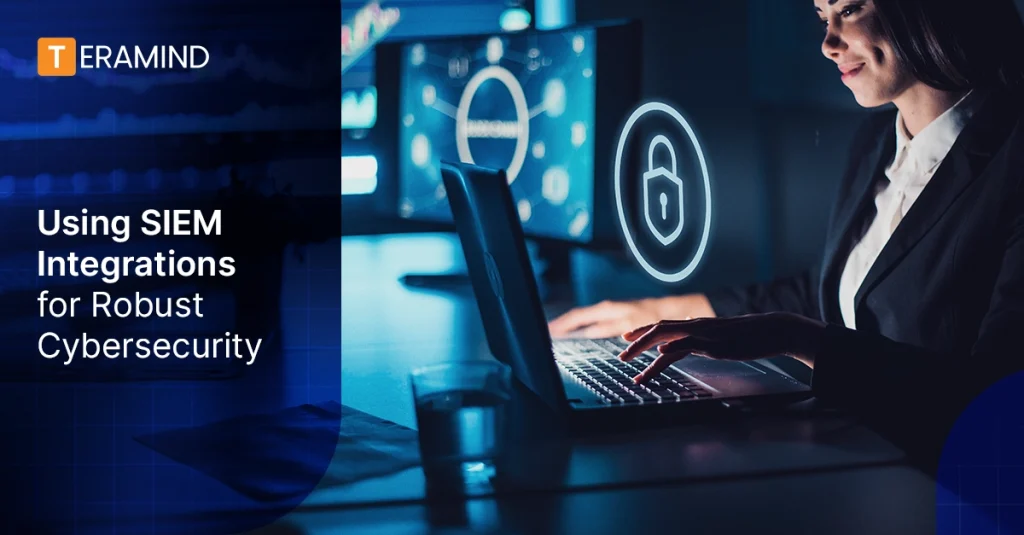The average cost of a cyberattack in the United States is 9.5 million. With over 60% of businesses going bankrupt after experiencing a severe data breach, robust security measures to safeguard organizations’ digital assets and operations are urgently needed.
A powerful tool gaining significant traction in addressing these challenges is Security Information and Event Management (SIEM). SIEM solutions offer a comprehensive approach to security by collecting, analyzing, and responding to security-related events across an organization’s entire infrastructure.
How SIEM Integrations Improve Your Security Posture
At its core, a SIEM system is a centralized hub for gathering and correlating security data from various sources. It integrates data from network devices, servers, applications, and security solutions to comprehensively view the overall security posture.
Better Data Protection
One of the key benefits of SIEM integrations is the assurance of comprehensive data protection.
Integrating various data sources ensures that all security events and audit log data are captured for real-time analysis. In turn, organizations have a more complete, time-sensitive picture of their security posture.
Advanced Detection Capabilities
SIEM solutions leverage advanced analytics and machine learning and artificial intelligence algorithms to detect anomalous behavior and identify patterns indicative of a cyber attack. However, the effectiveness of these detection capabilities relies heavily on the breadth and depth of the data being analyzed.
SIEM solutions can analyze broad datasets, increasing their ability to detect even the most sophisticated threats. With comprehensive data integration, SIEM solutions can correlate events across multiple systems and applications, identifying potential security threats that may go unnoticed when analyzed in isolation.
For instance, by integrating with an organization’s identity management system and network monitoring tools, SIEM security systems can detect suspicious activities, such as a series of failed login attempts followed by a successful login from an unusual location, potentially indicating a compromised account, malicious activity, or unauthorized access attempt.
Improved Security Operations
Effective SIEM integrations streamline security operations by automating many manual processes, such as event correlation, incident response, and log management. This automation reduces the workload on security teams and improves incident response times, enabling organizations to respond to threats more swiftly and effectively.
By consolidating security data from various sources, SIEM solutions can automatically correlate events based on predefined rules and workflows, reducing the need for manual analysis and correlation. SIEM integrations can automate incident response processes, such as quarantining infected systems, blocking malicious IP addresses, or initiating remediation workflows. Automated responses such as these significantly reduce the time required to contain and mitigate security incidents, minimizing potential damage and ensuring business continuity.
Use Cases for SIEM Integrations
SIEM integrations offer various use cases across various domains of an organization’s security strategy. Some key use cases include:
Improved Network Monitoring
By integrating SIEM with network devices like routers, switches, and firewalls, organizations can gain real-time visibility into their network traffic and activity. This visibility is crucial for detecting and responding to threats such as unauthorized access attempts, distributed denial of service (DDoS) attacks, and malicious network activity.
For example, if a SIEM solution detects an unusually high volume of traffic from a specific IP address or subnet, it can alert the organization’s security team to investigate further, potentially preventing a DDoS attack or data exfiltration attempt.
Additionally, SIEM solutions can provide a more comprehensive view of potential threats by correlating network data with other security data sources, such as endpoint protection solutions and user activity logs. This integration enables organizations to identify and respond to advanced persistent threats (APTs) or multi-stage attacks involving multiple vectors and components.
Track User & Entity Behavior Analytics (UEBA)
Integrating SIEM with user directories, identity management systems, and endpoint security solutions enables organizations to monitor and analyze user behavior across their digital ecosystem.
This capability, known as User and Entity Behavior Analytics (UEBA), is crucial for identifying potential insider threats, compromised accounts, or privilege misuse, allowing organizations to take corrective actions promptly. Analyzing user activity logs, authentication events, and endpoint data enables SIEM systems to establish baselines for normal user behavior and detect deviations that may indicate malicious or unauthorized activities.
For instance, if a user’s account exhibits unusual behavior, such as accessing sensitive data outside of their typical activities or logging in from an unfamiliar location, a SIEM solution could alert the organization’s security team for further investigation. UEBA can also help identify potential account compromises by detecting anomalies in user behavior patterns, such as sudden changes in access patterns, unusual file transfers, or suspicious email activities.
Log Management
A crucial aspect of SIEM integrations is log file management. SIEM solutions collect and centralize log data across an organization’s infrastructure by integrating with diverse systems and applications. As mentioned, this consolidated view of logs enables forensic analysis, compliance reporting, and incident investigation, providing valuable insights into potential security issues.
Effective log management through SIEM integrations ensures that all relevant log data, including logs from operating systems, applications, network devices, security solutions, and cloud services, is captured, stored, and accessible for analysis.
By centralizing this data, security teams can quickly search, filter, and analyze logs to identify potential threats, investigate security incidents, or meet compliance requirements. Furthermore, SIEM integrations can facilitate log normalization, ensuring that log data from various sources is standardized and formatted consistently.
Reduce False Positives
One of the challenges security teams face is the high volume of security alerts and false positives generated by various security solutions.
SIEM integrations can help reduce the number of false positive alerts by gathering additional context from multiple data sources. With more comprehensive data, SIEM solutions can apply advanced correlation rules and machine learning to distinguish between genuine threats and normal activity, reducing the noise and allowing security teams to focus on real threats.
For example, if an endpoint protection solution generates an alert about suspicious file activity, a SIEM solution can cross-reference this alert with network traffic data, user activity logs, and other relevant sources to determine if the activity is truly malicious.
Improved Compliance with Regulations & Standards
Many industries are subject to compliance requirements and security standards, such as HIPAA for healthcare organizations, PCI DSS for payment processors, and GDPR for organizations handling the personal data of EU citizens. SIEM integrations help organizations meet these standards by providing a centralized platform for log management, audit logging, and real-time monitoring of security events, ensuring that they can demonstrate compliance and maintain regulatory compliance.
SIEM centralized log management capability simplifies the process of generating compliance reports, enabling organizations to demonstrate adherence to regulatory requirements and industry standards.
Additionally, SIEM integrations’ real-time monitoring and analysis capabilities allow organizations to detect and respond to potential compliance violations promptly, minimizing the risk of non-compliance penalties or data breaches. Moreover, SIEM integrations can assist in meeting specific compliance requirements, such as maintaining segregation of duties, monitoring privileged user activities, or ensuring data integrity and confidentiality.
Conclusion
By leveraging SIEM integrations, organizations can gain a comprehensive view of their security posture, detect and respond to threats more efficiently, and meet compliance requirements more easily.
With the ability to collect and analyze data from diverse sources, such as network devices, endpoint security solutions, and cloud services, SIEM integrations provide a centralized platform for advanced threat detection, incident response, and security operations. By correlating events across multiple systems and leveraging advanced analytics, SIEM solutions can identify potential threats that may go unnoticed when analyzed in isolation, enabling proactive mitigation measures.
Whether organizations are evaluating SIEM solutions, troubleshooting an existing implementation, or learning strategies for successful integration, understanding the importance of SIEM integrations is paramount. With the right approach and a well-integrated SIEM system, organizations can fortify their defenses against cyber threats, safeguard their critical assets, and ensure business continuity in an increasingly complex digital ecosystem.

FAQs
What does SIEM stand for?
SIEM stands for Security Information and Event Management. It is a platform that combines real-time monitoring, log management, and analysis of security events to provide organizations with robust cybersecurity solutions.
What is an example of a SIEM tool?
An example of a SIEM tool is Splunk Enterprise Security, which combines real-time monitoring, log management, and event correlation to provide organizations with comprehensive cybersecurity solutions.
What is SIEM implementation?
SIEM implementation refers to the process of deploying and integrating a SIEM solution into an organization’s cybersecurity infrastructure to monitor and analyze security events effectively. This involves setting up the necessary hardware, software, and configurations and defining relevant policies and procedures for event management and response.
What is a SIEM vs SOC?
A SIEM (Security Information and Event Management) system is a platform that collects and analyzes security event data, while a SOC (Security Operations Center) is a team responsible for monitoring and responding to cybersecurity incidents. While a SIEM is a technology tool, a SOC is a dedicated team within an organization that utilizes the SIEM and other security tools to detect and respond to threats.
Can you have a SOC without a SIEM?
While it is possible to have a SOC without a SIEM, integrating a SIEM into a SOC enhances its capabilities for monitoring and responding to cybersecurity incidents. A SIEM provides real-time monitoring, log management, and event correlation, allowing the SOC team to detect and analyze security events more effectively.
How does a SIEM work in a SOC?
A SIEM works in a SOC by collecting and analyzing security event data from various sources, including logs and network traffic. It provides real-time monitoring and correlation of events, enabling the SOC team to detect and respond to cybersecurity incidents effectively.







